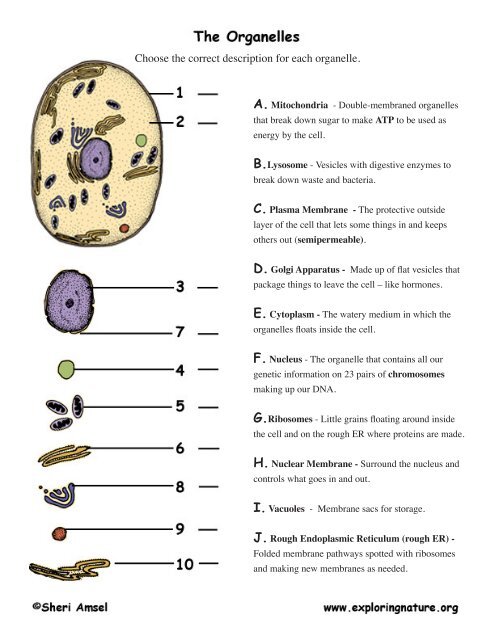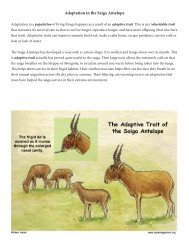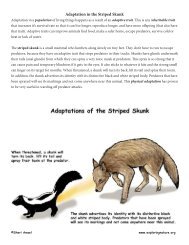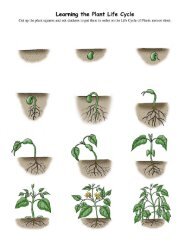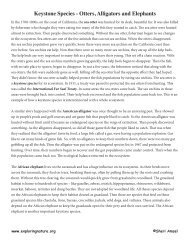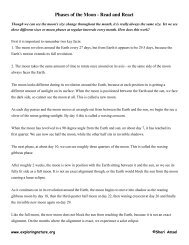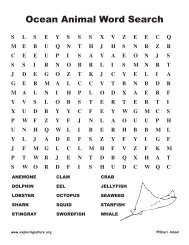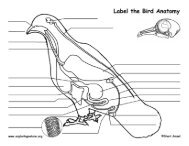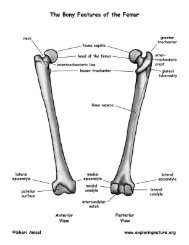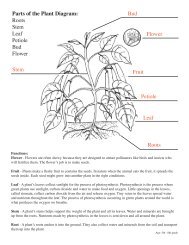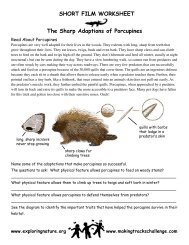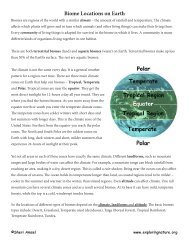Choose the correct description for each organelle.
Choose the correct description for each organelle.
Choose the correct description for each organelle.
You also want an ePaper? Increase the reach of your titles
YUMPU automatically turns print PDFs into web optimized ePapers that Google loves.
<strong>Choose</strong> <strong>the</strong> <strong>correct</strong> <strong>description</strong> <strong>for</strong> <strong>each</strong> <strong>organelle</strong>.<br />
A. Mitochondria - Double-membraned <strong>organelle</strong>s<br />
that break down sugar to make ATP to be used as<br />
energy by <strong>the</strong> cell.<br />
B.Lysosome - Vesicles with digestive enzymes to<br />
break down waste and bacteria.<br />
C. Plasma Membrane - The protective outside<br />
layer of <strong>the</strong> cell that lets some things in and keeps<br />
o<strong>the</strong>rs out (semipermeable).<br />
D. Golgi Apparatus - Made up of flat vesicles that<br />
package things to leave <strong>the</strong> cell – like hormones.<br />
E. Cytoplasm - The watery medium in which <strong>the</strong><br />
<strong>organelle</strong>s floats inside <strong>the</strong> cell.<br />
F. Nucleus - The <strong>organelle</strong> that contains all our<br />
genetic in<strong>for</strong>mation on 23 pairs of chromosomes<br />
making up our DNA.<br />
G.Ribosomes - Little grains floating around inside<br />
<strong>the</strong> cell and on <strong>the</strong> rough ER where proteins are made.<br />
H. Nuclear Membrane - Surround <strong>the</strong> nucleus and<br />
controls what goes in and out.<br />
I. Vacuoles - Membrane sacs <strong>for</strong> storage.<br />
J. Rough Endoplasmic Reticulum (rough ER) -<br />
Folded membrane pathways spotted with ribosomes<br />
and making new membranes as needed.
<strong>Choose</strong> <strong>the</strong> <strong>correct</strong> <strong>description</strong> <strong>for</strong> <strong>each</strong> <strong>organelle</strong>.<br />
A. Mitochondria - Double-membraned <strong>organelle</strong>s<br />
that break down sugar to make ATP to be used as<br />
energy by <strong>the</strong> cell.<br />
B.Lysosome - Vesicles with digestive enzymes to<br />
break down waste and bacteria.<br />
C. Plasma Membrane - The protective outside<br />
layer of <strong>the</strong> cell that lets some things in and keeps<br />
o<strong>the</strong>rs out (semipermeable).<br />
D. Golgi Apparatus - Made up of flat vesicles that<br />
package things to leave <strong>the</strong> cell – like hormones.<br />
E. Cytoplasm - The watery medium in which <strong>the</strong><br />
<strong>organelle</strong>s floats inside <strong>the</strong> cell.<br />
F. Nucleus - The <strong>organelle</strong> that contains all our<br />
genetic in<strong>for</strong>mation on 23 pairs of chromosomes<br />
making up our DNA.<br />
G.Ribosomes - Little grains floating around inside<br />
<strong>the</strong> cell and on <strong>the</strong> rough ER where proteins are made.<br />
H. Nuclear Membrane - Surround <strong>the</strong> nucleus and<br />
controls what goes in and out.<br />
I. Vacuoles - Membrane sacs <strong>for</strong> storage.<br />
J. Rough Endoplasmic Reticulum (rough ER) -<br />
Folded membrane pathways spotted with ribosomes<br />
and making new membranes as needed.
<strong>Choose</strong> <strong>the</strong> <strong>correct</strong> <strong>description</strong> <strong>for</strong> <strong>each</strong> <strong>organelle</strong>.<br />
C<br />
E<br />
A. Mitochondria - Double-membraned <strong>organelle</strong>s<br />
that break down sugar to make ATP to be used as<br />
energy by <strong>the</strong> cell.<br />
B.Lysosome - Vesicles with digestive enzymes to<br />
break down waste and bacteria.<br />
C. Plasma Membrane - The protective outside<br />
layer of <strong>the</strong> cell that lets some things in and keeps<br />
o<strong>the</strong>rs out (semipermeable).<br />
F<br />
D. Golgi Apparatus - Made up of flat vesicles that<br />
package things to leave <strong>the</strong> cell – like hormones.<br />
H<br />
I<br />
A<br />
G<br />
D<br />
B<br />
J<br />
E. Cytoplasm - The watery medium in which <strong>the</strong><br />
<strong>organelle</strong>s floats inside <strong>the</strong> cell.<br />
F. Nucleus - The <strong>organelle</strong> that contains all our<br />
genetic in<strong>for</strong>mation on 23 pairs of chromosomes<br />
making up our DNA.<br />
G.Ribosomes - Little grains floating around inside<br />
<strong>the</strong> cell and on <strong>the</strong> rough ER where proteins are made.<br />
H. Nuclear Membrane - Surround <strong>the</strong> nucleus and<br />
controls what goes in and out.<br />
I. Vacuoles - Membrane sacs <strong>for</strong> storage.<br />
J. Rough Endoplasmic Reticulum (rough ER) -<br />
Folded membrane pathways spotted with ribosomes<br />
and making new membranes as needed.


